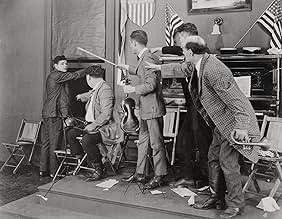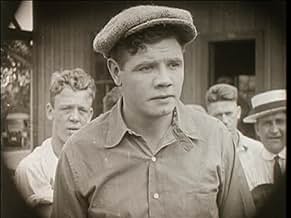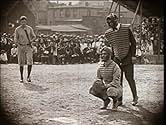Agrega una trama en tu idiomaThe "true story" of baseball great Babe Ruth; Ruth plays himself.The "true story" of baseball great Babe Ruth; Ruth plays himself.The "true story" of baseball great Babe Ruth; Ruth plays himself.
- Dirección
- Guionistas
- Elenco
Ralf Harolde
- John Tobin
- (as Ralph Harolds)
Charles Byer
- David Talmadge
- (as Charles Burt)
Ann Brody
- Mrs. Tony Marino
- (as Anne Brodie)
Sammy Blum
- Jimbo Jones
- (as Sam Blum)
Tom Cameron
- Deacon Flack
- (as Thomas Cameron)
- Dirección
- Guionistas
- Todo el elenco y el equipo
- Producción, taquilla y más en IMDbPro
Opiniones destacadas
Boy howdy, if this isn't a trip through time, and maybe even more so than other works of the silent era. Porkpie hats galore; effusive intertitle representation of colloquial phrases, slang, and dialects that are practically another language one century later; self-mythologizing that makes T. E. Lawrence's exaggerations of his escapades look like a little white lie. And to top it all off, 'Headin' home' is a fictionalized biography that is presented as loose narrative fiction, with focus at times on tertiary figures who have nothing to do with the man himself! Very light "comedy," and very light "drama," are really nothing more than an excuse to give baseball legend Babe Ruth his own movie - and at times, it seems, to allow the folks writing the intertitles to let their imagination run wild, seemingly with the aid of several bottles of a favored alcohol beverage.
Neither Ruth, nor writers Arthur "Bugs" Baer or Earle Browne, nor director Lawrence C. Windom were a Buster Keaton or a Harold Lloyd, and this flick is no exemplar of humor or of this period in cinema. Anyone who isn't already enamored of silent films may not find anything here to change their mind. Be that as it may, it's modestly enjoyable on its own merits, and there are some small bits and pieces that are unexpectedly keen. The writers may have been imbibing a brew or five while penning the intertitles, but every now and again they slip in an especially witty line, such as a reference to the League of Nations and Woodrow Wilson's peace plan following World War I, or sly wordplay. Some scenes herein would fit neatly within a feature from a contemporary comedic icon, and for that matter - replace the central sports figure with any other actor, and at once the storytelling in 'Headin' home' would both be less noteworthy, but also right in line with most any picture of 1920. Granted, I think the story is a tad unfocused, and maybe even scattered; there are also instances where the contemporary references in the intertitles are so firmly cemented that a modern viewer can only make inferences as to the full meaning. All the same, these criticisms are no worse than can be said for what other writers have conjured.
In addition to old fashion and old language, it's striking to see depictions of period sports equipment and facilities. In every other capacity this title is well made, if unremarkable - some filmmakers were pushing the envelope and innovating in the medium, and others were happy just to have their fare sell tickets and entertain, and this is an example of the latter. It's all that it needs to be to provide a good time, though, and after all, that was the only earnest intent. It's no lightning bolt of genius, but it does actually earn a few laughs, and overall it's exactly the lighthearted fun that it wants to be. If one is a huge fan of baseball or of Babe Ruth then it will surely come more highly recommended, yet even for the casual viewer this is a splendid diversion for a quiet day. Don't go out of your way for 'Headin' home,' but if you do have the opportunity to watch, this is a fine movie that stands pretty solidly on its own feet even over one hundred years later. Not every winner needs to hit a home run, and this ably runs the bases all by itself.
Neither Ruth, nor writers Arthur "Bugs" Baer or Earle Browne, nor director Lawrence C. Windom were a Buster Keaton or a Harold Lloyd, and this flick is no exemplar of humor or of this period in cinema. Anyone who isn't already enamored of silent films may not find anything here to change their mind. Be that as it may, it's modestly enjoyable on its own merits, and there are some small bits and pieces that are unexpectedly keen. The writers may have been imbibing a brew or five while penning the intertitles, but every now and again they slip in an especially witty line, such as a reference to the League of Nations and Woodrow Wilson's peace plan following World War I, or sly wordplay. Some scenes herein would fit neatly within a feature from a contemporary comedic icon, and for that matter - replace the central sports figure with any other actor, and at once the storytelling in 'Headin' home' would both be less noteworthy, but also right in line with most any picture of 1920. Granted, I think the story is a tad unfocused, and maybe even scattered; there are also instances where the contemporary references in the intertitles are so firmly cemented that a modern viewer can only make inferences as to the full meaning. All the same, these criticisms are no worse than can be said for what other writers have conjured.
In addition to old fashion and old language, it's striking to see depictions of period sports equipment and facilities. In every other capacity this title is well made, if unremarkable - some filmmakers were pushing the envelope and innovating in the medium, and others were happy just to have their fare sell tickets and entertain, and this is an example of the latter. It's all that it needs to be to provide a good time, though, and after all, that was the only earnest intent. It's no lightning bolt of genius, but it does actually earn a few laughs, and overall it's exactly the lighthearted fun that it wants to be. If one is a huge fan of baseball or of Babe Ruth then it will surely come more highly recommended, yet even for the casual viewer this is a splendid diversion for a quiet day. Don't go out of your way for 'Headin' home,' but if you do have the opportunity to watch, this is a fine movie that stands pretty solidly on its own feet even over one hundred years later. Not every winner needs to hit a home run, and this ably runs the bases all by itself.
The movie hardly makes sense. However, its redeeming value is seeing a young Babe Ruth and the historical footage of the Polo Grounds as it appeared in 1920. The highlight is seeing Ruth at bat in a real game -- the pitcher winds and throws and the Babe swings and hits the ball, and then runs the bases. Terrific stuff. Early in the film Babe takes a turn on the mound. Before he gained fame as a hitter he was an outstanding major league pitcher. The scene involves a sandlot game. I'm not sure Babe gave it his actual windup, but it looked good and professional. The view of the Polo Grounds stands shows the largely male crowd in derby and straw hats. The closing shot was taken from the clubhouse area, which was in back of centerfield. It's too bad all this happens at the very end of the picture.
This film which purports to chronicle the childhood of the Babe is almost entirely a fabrication....he didn't grow up in some small town....he grew up near the waterfront docks of Baltimore,MD for the first few years of his life where his father owned and ran a saloon that catered to a very rough crowd.Young George was largely unsupervised most of the time and was continually getting into one scrape or another...as a result George Sr had him enrolled in the St. Mary's Industrial School for boys and pretty much stayed out of young George's life from then on...I'm sure this film's version made for better publicity for the up and coming Babe as well as for the Yankees...Colonel Ruppert was very mindful of his team's public image and making a film about the real version of Babe's young life at that time would have had a lot of negative consequences
Babe Ruth - in addition to being perhaps the greatest baseball player ever - had quite a little side-gig going in Hollywood films. He appeared in several - always as "Babe" (usually but not always as Babe Ruth, but always as "Babe.") "Headin' Home" was his first ever appearance in the movies. Yes, he plays "Babe" - a small town boy who makes it to the big time. Was he playing himself? No. The story of this Babe's life is nothing like the story of Babe Ruth's life, but it's still interesting and enjoyable to watch this silent movie.
This Babe grew up in the small town of Haverlock, fiercely devoted to his apparently single mother and his foster sister. The real Babe grew up in a Baltimore suburb until he was farmed out to an orphanage, after which he only rarely saw his family. So this is most definitely not a biography in any way, shape or form, although you get the definite impression that the producers wanted people to think it was a biography and that Babe Ruth was playing Babe Ruth instead of just plain Babe, since the opening shot of the Bambino has him in his Yankees cap.
But since this story bares absolutely no resemblance to Babe Ruth's real life, I'm not going to call it inaccurate; I'm going to assume it's fiction. As fiction, it's pleasant enough and it even tries to be funny, although jokes told on the title cards used in silent movies don't really work very well. It's most interesting for a look at a very young Babe Ruth - before he put on weight. He's pretty slim and trim in this. There's also a bit of politics mixed on that you have to watch for. This was made in 1920. Woodrow Wilson, until he suffered a stroke in late 1919, had been aggressively promoting Senate passage of the Treaty of Versailles that ended World War I. I thought it interesting that, in a veiled sort of way, there was mention of the "14 points" - Wilson's plan that led to the Treaty - and to the League of Nations - Wilson's brainchild that Senate Republicans were fiercely opposed to. There's even a bit of a crazy dogcatcher who's clearly identified as a Republican. Was a political point in favour of Versailles being made? I don't know.
This is an enjoyable, fun movie. (7/0)
This Babe grew up in the small town of Haverlock, fiercely devoted to his apparently single mother and his foster sister. The real Babe grew up in a Baltimore suburb until he was farmed out to an orphanage, after which he only rarely saw his family. So this is most definitely not a biography in any way, shape or form, although you get the definite impression that the producers wanted people to think it was a biography and that Babe Ruth was playing Babe Ruth instead of just plain Babe, since the opening shot of the Bambino has him in his Yankees cap.
But since this story bares absolutely no resemblance to Babe Ruth's real life, I'm not going to call it inaccurate; I'm going to assume it's fiction. As fiction, it's pleasant enough and it even tries to be funny, although jokes told on the title cards used in silent movies don't really work very well. It's most interesting for a look at a very young Babe Ruth - before he put on weight. He's pretty slim and trim in this. There's also a bit of politics mixed on that you have to watch for. This was made in 1920. Woodrow Wilson, until he suffered a stroke in late 1919, had been aggressively promoting Senate passage of the Treaty of Versailles that ended World War I. I thought it interesting that, in a veiled sort of way, there was mention of the "14 points" - Wilson's plan that led to the Treaty - and to the League of Nations - Wilson's brainchild that Senate Republicans were fiercely opposed to. There's even a bit of a crazy dogcatcher who's clearly identified as a Republican. Was a political point in favour of Versailles being made? I don't know.
This is an enjoyable, fun movie. (7/0)
For anyone wanting to find out about the real life Babe Ruth, this "true story" should be avoided at all costs! Created in 1920, this film purports to be about the Bambino and his rise to fame, but frankly almost none of it bears any similarity to the slugger. In the film, he's a small town boy who is shy and unassuming. In real life, he grew up in the "rustic small town" of Baltimore, Maryland and was a bit of a juvenile delinquent--but I guess this image makes for a rather unappealing film! Now the fact that they played so fast and loose with the facts wasn't totally awful--after all, many of our heroes of times past have an aura of fiction about them. But the fiction they created is so schmaltzy and saccharine that it becomes almost laughable. Babe does practically everything in the film but walk on water and heal the sick! The fact that many at the time believed this is what is so amazing about this film. The only truth in the film is that the writers describe his as ugly--something I am surprised Ruth allowed. I guess he wasn't too hung up about his looks.
Speaking of looks, Babe is quite young in the film--and rather trim after his first season with the Yankees. Oddly, though, he'd been a very famous pitcher with the Red Sox but this is never alluded to in the film--but his prowess with the bat sure is. In fact, in the movie he made the bat himself--something reminiscent of Robert Redford's character in THE NATURAL.
Now I am sure you gather that the historical aspects of this film are dubious, at best. As for the entertainment value and quality of the film, it's not bad--especially for 1920. While people today will most likely laugh at the silly and over-the-top plot, the audience of 1920 ate it up and the film was well-produced and kept my interest.
Overall, I give it a 7 as entertainment and a 1 for historical accuracy!
Speaking of looks, Babe is quite young in the film--and rather trim after his first season with the Yankees. Oddly, though, he'd been a very famous pitcher with the Red Sox but this is never alluded to in the film--but his prowess with the bat sure is. In fact, in the movie he made the bat himself--something reminiscent of Robert Redford's character in THE NATURAL.
Now I am sure you gather that the historical aspects of this film are dubious, at best. As for the entertainment value and quality of the film, it's not bad--especially for 1920. While people today will most likely laugh at the silly and over-the-top plot, the audience of 1920 ate it up and the film was well-produced and kept my interest.
Overall, I give it a 7 as entertainment and a 1 for historical accuracy!
¿Sabías que…?
- TriviaBabe Ruth received $25,000 for this, his first film. The sum was a large amount for the time, and Ruth refused to cash his paycheck and carried it around to show to friends. By the time Ruth had decided to cash his check for the film, the check bounced because of the film's poor box office results. Ruth shrugged off his loss and kept the check as a memento.
- ConexionesFeatured in Fractured Flickers: Rod Serling (1963)
Selecciones populares
Inicia sesión para calificar y agrega a la lista de videos para obtener recomendaciones personalizadas
Detalles
- Tiempo de ejecución
- 1h 11min(71 min)
- Color
- Mezcla de sonido
- Relación de aspecto
- 1.33 : 1
Contribuir a esta página
Sugiere una edición o agrega el contenido que falta























